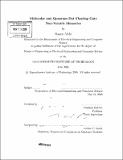| dc.contributor.advisor | Vladimir Bulovic. | en_US |
| dc.contributor.author | Abdu, Hassen | en_US |
| dc.contributor.other | Massachusetts Institute of Technology. Dept. of Electrical Engineering and Computer Science. | en_US |
| dc.date.accessioned | 2009-06-30T16:23:04Z | |
| dc.date.available | 2009-06-30T16:23:04Z | |
| dc.date.copyright | 2008 | en_US |
| dc.date.issued | 2008 | en_US |
| dc.identifier.uri | http://hdl.handle.net/1721.1/45827 | |
| dc.description | Thesis (M. Eng.)--Massachusetts Institute of Technology, Dept. of Electrical Engineering and Computer Science, 2008. | en_US |
| dc.description | Includes bibliographical references (p. 75-76). | en_US |
| dc.description.abstract | Conventional Flash memory devices face a scaling issue that will impede memory scaling beyond the 50nm node: a reliability issue involving the tunneling oxide thickness and charge retention. A possible solution is to replace the continuous floating gate, where charge is stored, with a segmented charge storage film, so that leakage through defects in the tunneling oxide would be localized. We first explored using quantum dots as possible floating gate replacements. After conducting simulations, we established the need for the smallest possible segmented structures. This led us to the use of molecular films as floating gates in non-volatile flash memories. As an example, a single organic molecule of 3,4,9,10 -parylene tetracarboxylic dianhydride (PTCDA) occupies lnm2 in area and is capable of storing and retaining a single charge. If a defect is present in the tunneling oxide below the floating gate, only a few molecules of PTCDA would be affected due to poor lateral conduction between PTCDA molecules. We can, therefore, project that such molecular thin films of PTCDA are likely to meet demanding size and packing density requirements of advancing flash memory technology. | en_US |
| dc.description.statementofresponsibility | by Hassen Abdu. | en_US |
| dc.format.extent | 76 p. | en_US |
| dc.language.iso | eng | en_US |
| dc.publisher | Massachusetts Institute of Technology | en_US |
| dc.rights | M.I.T. theses are protected by
copyright. They may be viewed from this source for any purpose, but
reproduction or distribution in any format is prohibited without written
permission. See provided URL for inquiries about permission. | en_US |
| dc.rights.uri | http://dspace.mit.edu/handle/1721.1/7582 | en_US |
| dc.subject | Electrical Engineering and Computer Science. | en_US |
| dc.title | Molecular and quantum dot floating gate non-volatile memories | en_US |
| dc.type | Thesis | en_US |
| dc.description.degree | M.Eng. | en_US |
| dc.contributor.department | Massachusetts Institute of Technology. Department of Electrical Engineering and Computer Science | |
| dc.identifier.oclc | 319435526 | en_US |
